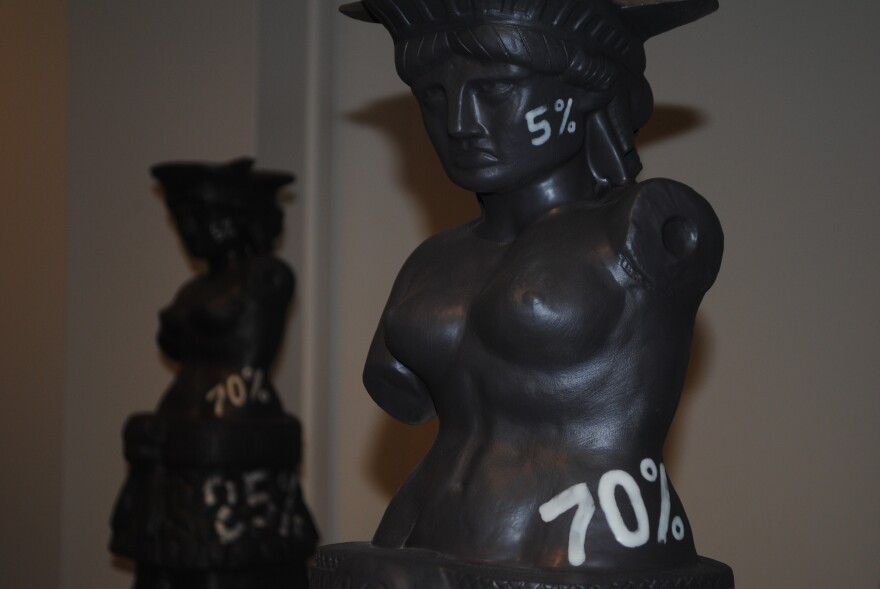“Latino Art of the Midwest: Into the 21st century” is a special exhibit presented by the Roesch Library Gallery on University of Dayton’s campus. It features 13 artists, all Latinos living in the midwest.
On a tour of the show on opening night, curator Judith Huacuja stresses light as the major theme.
“There’s a bright halo, so the light is hope that comes from above,” she explains, gesturing towards a painting by Sergio Gomez that depicts two abstracts figures beneath a stream of light.

Huacuja also points out four identical statues, each a mixture of three different art styles—from the waist down, an imitation of an Aztec stone sculpture of a goddess; from the waist up, a sort of Venus de Milo, an iconic European statue; the heads are each the head of the Statue of Liberty.
“What’s missing is that icon which we most think of with the Statue of Liberty her holding up that great torch of light that represents liberty, freedom,” she says. It’s the absence of light that adds to the message of these hybrid sculptures.
Another theme running through the 47 pieces in the art show is line.
The lines in Artist Graciela Bustos’ work criss-cross and overlay her photographs. In her artist statement, she writes, “without lines there would be no existence. Consider the lines that influence our lives: lifeline, finish line, straight line, head line, fine line.”
The artists in this show hail from Tennessee, Michigan, Ohio, and as far north as Wisconsin.
Artist Raoul Deal came to Milwaukee from Mexico in 1998; he makes heavy-black and stark-white woodcuts that depict street protests where people express their rights in immigration. In a phone interview with WYSO, he says Milwaukee has an active Latino arts center and community.

“You have that happening, alongside of the activist art which is just coming up through alliances with the Black Lives Matter movement, and a sort of a black-brown alliance which I think is very important and very interesting,” Deal says. “It shows itself in the cultural activities, in both art and music and spoken word, and throughout culture in Milwaukee right now, very powerful.“
But he says Milwaukee still has a long way to go.
“There’s diversity but there’s also racism and segregation. We have the dubious distinction every year of being named the most segregated city in the country.”
The themes of segregation—lines and borders—are present in Deal’s work, and throughout the show.
Curator Judith Huacuja, who identifies herself as a Chicana scholar, has researched both Latin American and African American art traditions.
“The experience of most people who are Latino, Latin American, is that they have crossed borders either legally or illegally,” she says. “In crossing the border you leave behind a cultural homeland a sense of identity, and you move into a place you seek acculturation the mixing together of your sense of identification with the new American system but you retain parts of your previous identity.”

The piece on all of the postcards advertising the exhibit, “The Bleeding Border,” by Sergio Gomez, depicts two children crossing a dark border wall through a bright door. A huge bleeding cut spans the whole landscape as if the canvas itself was slashed. Here, Huacuja says, the light “comes from the helicopter. It’s the light of surveillance, the light of scrutiny, the light of questioning who you are and if you have the right to be here. ”
The art will be on display at the Roesch Library on University of Dayton’s campus through March 21, when Huacuja will give a curator’s talk at 5 p.m.








